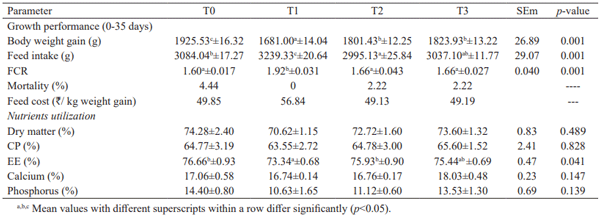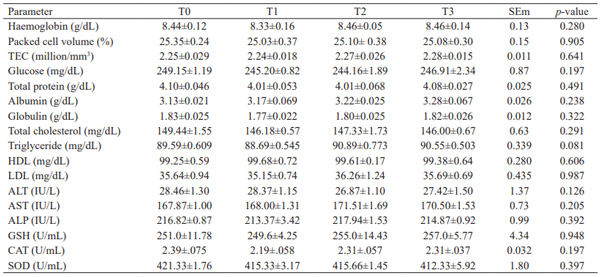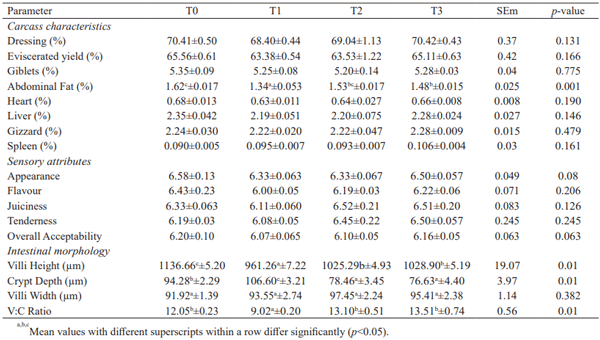Comparative efficacy of synthetic and herbal emulsifiers in broiler chicken fed energy-restricted diet
The digestive system of young birds is very poor and inefficient in digestion and absorption of fat due to less lipase production and low rate of bile formation, which can be overcome by the use of exogenous emulsifier. This study aimed to evaluate the comparative efficacy of exogenous herbal and synthetic emulsifiers on growth performance, nutrients utilization, haemato-biochemical profile, and carcass quality in broiler chickens fed energy restricted diet during a 35-days feeding trial. 180 one day-old Cobb400Y chicks were assigned into four treatment groups, each with three replicates. T0(control) received a basal diet without emulsifier, group T1 received a basal diet with 3% less metabolizable energy, group T2 received a basal diet with 3% less metabolizable energy + synthetic emulsifier @250 g/tonne of feed and group T3 received a basal diet with 3% less metabolizable energy + herbal emulsifier @ 250 g/tonne of feed. Supplementation of exogenous emulsifier enhanced growth performance and economics of broiler chicken. These was no significant effect of exogenous emulsifiers on dry matter, crude protein, calcium and phosphorus retention in broiler chickens, however, retention of ether extract improved significantly. Haematological parameters, carcass characteristics and overall acceptability of meat of broiler chicken fed diets supplemented with emulsifiers in energy restricted diets didn`t differ. Emulsifier supplementation didn’t change villi length and crypt depth. It was concluded that decrease in 3% metabolizable energy of broiler chicken diet depressed growth performance and economics of broiler chicken whereas, dietary supplementation of emulsifier @ 250 g/ tonne of energy restricted based broiler feed improved the growth performance, ether extract utilization, intestinal morphology and economics without affecting haemato-biochemical profile, and carcass quality of broiler chickens.
Keywords: Broiler, Carcass, Emulsifier, Growth, Haemato-biochemical
MATERIALS AND METHODS

RESULTS AND DISCUSSION



Abbas M T, Arif M, Saeed M, Reyad-ul-Ferdous M, Hassan M A, Arain M A and Rehman A. 2016. Emulsifier effect on fat utilization in broiler chicken. Asian Journal of Animal and Veterinary Advances 11(3): 158–67.
Aguilar Y M, Becerra J C, Bertot R R, Peláez J C, Liu G and Hurtado C B. 2013. Growth performance, carcass traits and lipid profile of broiler chicks fed with an exogenous emulsifier and increasing levels of energy provided by palm oil. Journal of Food, Agriculture and Environment 11(1): 629–33.
Allahyari-Bake S and Jahanian R. 2017. Effects of dietary fat source and supplemental lysophosphatidylcholine on performance, immune responses, and ileal nutrient digestibility in broilers fed corn/soybean meal-or corn/wheat/soybean meal-based diets. Poultry Science 96(5): 1149–58.
AOAC. 2007. Official Methods of Analysis of the Association of Official’s Analytical Chemists. 17th Edn, Association of Official Analytical Chemists, Arlington,Virginia
BIS. 2007. Indian Standard: Poultry Feeds- Specification, IS-374. Bureau of Indian Standards, 9, Bahadur Sah Zafar Marg, Manak Bhawan, New Delhi, India.
Blanch A, Barroeta A C, Baucells M D, Serrano X and Puchal F. 1996. Utilization of different fats and oils by adult chickens as a source of energy, lipid and fatty acids. Animal Feed Science and Technology 61(1-4): 335–42.
Bontempo V, Comi M, Jiang X R, Rebucci R, Caprarulo V, Giromini C, Gottardo D, Fusi E, Stella S, Tirloni E and Cattaneo D. 2018. Evaluation of a synthetic emulsifier product supplementation on broiler chicks. Animal Feed Science and Technology 240: 157–64.
Boontiam W, Jung B and Kim Y Y. 2017. Effects of lysophospholipid supplementation to lower nutrient diets on growth performance, intestinal morphology, and blood metabolites in broiler chickens. Poultry Science 96(3): 593– 601.
Chen S Y, Liu Z X, He Y D, Chu C and Wang M Q. 2014. Effect of coated lipase supplementation on growth, digestion and intestinal morphology in weaning piglets. Journal of Animal and Veterinary Advances 13: 1013–17.
Chen C, Jung, B and Kim W K. 2019. Effects of lysophospholipid on growth performance, carcass yield, intestinal development, and bone quality in broilers. Poultry Science 98: 3902–13.
Cho J H, Zhao P and Kim I H. 2012. Effects of emulsifier and multi-enzyme in different energy densitydiet on growth performance, blood profiles, and relative organ weight in broiler chickens. Journal of Agricultural Science 4(10): 161– 68.
Cohen G, Dembiec D and Marcus J. 1970. Measurement of catalase activity in tissue extracts. Analytical Biochemistry 34(1): 30–38.
Gole M, Manwar S, Khose K, Rathod P, Kumar D and Ganguly R K. 2022. Efficacy evaluation of a poultry feed emulsifier in broiler chicken. The Pharma Innovation Journal 11(1): 11–19.
Hu, X Q, Wang W B, Liu L, Wang C, Feng W, Luo Q P, Han R and Wang X D. 2019. Effects of fat type and emulsifier in feed on growth performance, slaughter traits, and lipid metabolism of Cherry Valley ducks. Poultry Science 98(11): 5759–66.
Hu Y D, Lan D, Zhu Y, Pang H Z, Mu X P and Hu X F. 2018. Effect of diets with different energy and lipase levels on performance, digestibility and carcass trait in broilers. AsianAustralasian Journal of Animal Sciences 31(8): 1275–84.
Huang J, Yang D and Wang T. 2007. Effects of replacing soy-oil with soy-lecithin on growth performance, nutrient utilization and serum parameters of broilers fed corn-based diets. AsianAustralasian Journal of Animal Sciences 20(12): 1880–86.
Johnson A M, Rohifs E M and Silverman L M. 1999. Protein. The Textbook of Clinical Chemistry. W.B. Saunders Philadelphia.
Kaczmarek S A, Bochenek M, Samuelsson A C and Rutkowski A. 2015. Effects of glyceryl polyethylene glycol ricinoleate on nutrient utilisation and performance of broiler chickens. Archives of Animal Nutrition 69(4): 285–96.
Keeton J T, Foegeding E A and Patana‐Anake C. 1984. A comparison of nonmeat proteins, sodium tripolyphosphate and processing temperature effects on physical and sensory properties of frankfurters. Journal of Food Science 49(6): 1462–65.
Kim W T, Shinde P and Chae B J. 2008. Effect of lecithin with or without chito oligosaccharide on the growth performance, nutrient digestibility, blood metabolites and pork quality of finishing pigs. Canadian Journal of Animal Science 88(2): 283–92.
Kramer C Y. 1957. Extension of multiple range tests to group correlated adjusted means. Biometrics 13(1): 13–18.
Kussaibati R, Guillaume J and Leclercq B. 1982. The effects of age, dietary fat and bile salts, and feeding rate on apparent and true metabolisable energy values in chickens. British Poultry Science 23(5): 393–403.
Lin H M, Dillard C J and Tappel A L. 1988. Plasma SH and GSH measurements. Methods Enzymology 233: 380–82.
Madesh M and Balasubramanian K A. 1998. Microtiter plate assay for superoxide dismutase using MTT reduction by superoxide. Indian Journal of Biochemistry and Biophysics 35(3): 184–88.
Meng X, Slominski B A and Guenter W. 2004. The effect of fat type, carbohydrase, and lipase addition on growth performance and nutrient utilization of young broilers fed wheat-based diets. Poultry Science 83(10): 1718–27.
Polin D and Hussein T H. 1982. The effect of bile acid on lipid and nitrogen retention, carcass composition, and dietary metabolizable energy in very young chicks. Poultry Science 61(8): 1697–1707.
Reitman S and Frankel S. 1957. Glutamic–pyruvate transaminase assay by colorimetric method. American Journal of Clinical Pathology 28(1): 56–63.
Rodriguez-Sanchez R, Tres A, Sala R, Guardiola F and Barroeta A C. 2019. Evolution of lipid classes and fatty acid digestibility along the gastrointestinal tract of broiler chickens fed different fat sources at different ages. Poultry Science 98: 1341–53.
Roy A, Haldar S, Mondal S and Ghosh T K. 2010. Effects of supplemental exogenous emulsifier on performance, nutrient metabolism, and serum lipid profile in broiler chickens. Veterinary Medicine International. Doi: https://doi. org/10.4061/ 2010/ 262604 (Accessed on 11th July 2022).
Schaible P J. 1970. Poultry: Feeds and Nutrition. 2nd Edn., The AVI Publishing Co. USA
Siyal F A, Babazadeh D, Wang C, Arain M A, Saeed M, Ayasan T, Zhang L and Wang T. 2017. Emulsifiers in poultry industry- A review. World Poultry Science Journal 73: 1–6.
Snedecor G W and Cochran W G. 1994. Statistical Methods. 8th Edn. IOWA State University Press. Ames, Iowa, USA.
Suleiman S A, Ali M E, Zaki Z M S, El‐Malik E M A and Nasr M A. 1996. Lipid peroxidation and human sperm motility: Protective role of vitamin E. Journal of Andrology 17(5): 530–37.
Talapatra S K, Ray S C and Sen K C. 1940. The analysis of mineral constituents in biological materials. 1. Estimation of phosphorus, chlorine, calcium, magnesium, sodium and potassium in food-stuffs. Indian Journal of Veterinary Science 10: 243–58.
Tikare V, Matham V K, Patil V, Chandra S, Kumar D, Kotagiri R and Ganguly B. 2021. Efficacy evaluation of poultry feed emulsifier on performance and nutrient metabolism in Broiler Chicken. Current Journal of Applied Science and Technology 40(48): 38–43.
Weiss D J and Wardrop K J. 2011. Schalm’s Veterinary Hematology. John Wiley & Sons.
Wickramasuriya S S, Cho H M, Macelline S P, Kim E, Shin T K, Yi Y J, Park S H, Lee K B and Heo J M. 2020. Effect of calcium stearoyl-2 lactylate and lipase supplementation on growth performance, gut health, and nutrient digestibility of broiler chickens. Asian-Australasian Journal of Animal Sciences 33(6): 981–91.
Xu Z R, Hu C H, Xia M S, Zhan X A and Wang M Q. 2003. Effects of dietary fructooligosaccharide on digestive enzyme activities, intestinal microflora and morphology of male broilers. Poultry Science 82(6): 1030–36.
Zampiga M, Meluzzi A and Sirri F. 2016. Effect of dietary supplementation of lysophospholipids on productive performance, nutrient digestibility and carcass quality traits of broiler chickens. Italian Journal of Animal Science 15(3): 521–28.
Zhang B, Haitao L, Zhao D, Guoand Y and Barri A. 2011. Effect of fat type and lysophosphatidylcholine addition to broiler diets on performance, apparent digestibility of fatty acids and apparent metabolisable energy content. Feed Science and Technology 163: 177–84.
Zhao P Y and Kim I H. 2017. Effect of diets with different energy and lysophospholipids levels on performance, nutrient metabolism, and body composition in broilers. Poultry Science 96(5): 1341–47.











.jpg&w=3840&q=75)